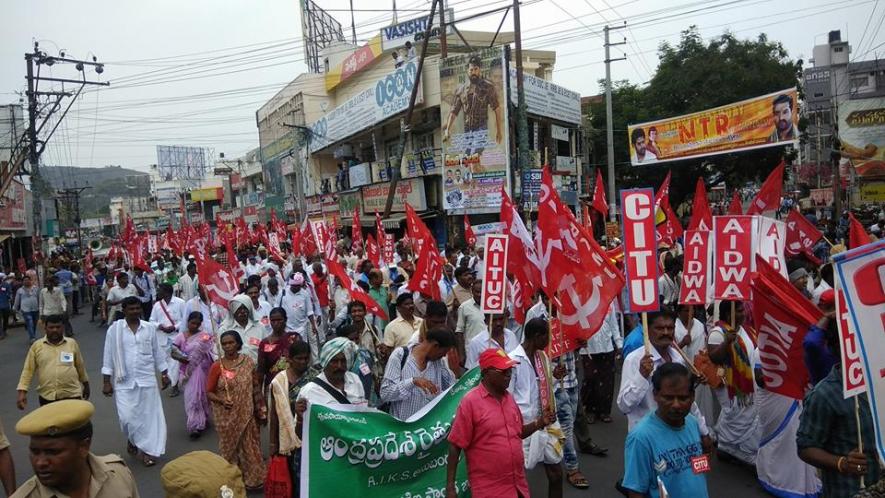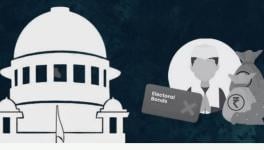Thousands Protest Across the Country to Mark the Completion of 4 Years of Modi Government

Three days ahead of the completion four years of the BJP-led NDA government under the Prime Ministership of Narendra Modi, 86 left and progressive organisations in India - including trade unions, farmers’ unions, women’s rights organisations, civil societies and unions of public sector employees, students, writers etc - came together for a country-wide protest attended by thousands on May 23 under the banner of Jan Ekta Jan Adhikar Andolan (People’s unity, People’s Rights movement).
Worsening of agrarian distress, rapidly increasing unemployment, worsening of healthcare, systematic violent attacks on minorities and dissidents, legitimization of atrocities against women are some of the major issues against which voices were raised in this protest.
In 2014, there was a widespread resentment in the country against the previous Congress-led UPA government, which, in its pursuit of neoliberal policies, had failed to alleviate the farmers’ agony and create sufficient jobs.
Promising to create 2 crore jobs a year and to provide a Minimum Support Price (MSP) of 50% over the cost of production for farmers, Narendra Modi won the election with a huge mandate, inflicting on the Congress party one of the worst ever defeats it had suffered.
The Great Betrayal
Less than a year after forming the government, in response to a Public Interest Litigation (PIL) filed by the Consortium of Indian Farmers' Association demanding that the government provide the MSP that was promised both by Narendra Modi and his party’s manifesto, the government told the Supreme Court that it was impossible to provide an MSP of 50% over the cost production, as doing so would distort the market.
Up until 2015, 3 lakh farmers, unable to cope with the agrarian distress, had resorted to committing suicide over a period of two decades. In 2015, a year after the current government came to power, this alarming rate of farmer-suicide rose further by almost 42%. 8,007 farmers killed themselves that year - over 3,000 more than the previous year’s 5,650, according to National Crime Records Bureau.
The abysmally low rate of 3.5% at which the agricultural sector - which employs 52% of the country’s population - was growing over a period of three years before the current government came to power, was almost halved, as the sector struggled at a growth rate of 1.7% over the first three years of Modi government.
In the Global Hunger Index of last year, which ranked 119 developing countries, India slipped by three positions and stood at 100th rank, trailing well behind Bangladesh, North Korea and even the war-torn Iraq. Only Afghanistan and Pakistan were Asian countries hungrier than India.
The agrarian distress, to be sure, has been haunting farmers in the country since its economy had been liberalized in the 1990s. Over the last two decades, everyday more than 2,000 people on an average have been giving up full-time farming. Manufacturing and construction jobs in urban areas was what a large number of those displaced from agriculture had been falling back on.
Unprecedented job-losses under Modi-government
However, these sectors have not only failed to grow sufficiently to accommodate the lakhs of more people displaced from agriculture, but has in fact lost the existing jobs. Within two years after the current government came to power in 2014, there has been a job loss of 21 lakh in manufacturing sector, and another 4.2 lakh in the construction sector.
While Narendra Modi had promised to create 2 crore jobs every year while campaigning for the elections, what followed after he assumed Prime Ministership was the first known instance of an absolute decline in employment in independent India’s history. In other words, if all the new people that enter the job market each year do not find jobs, then there is an increase in unemployment. But in these two years, for the first known time, not only was there no additional jobs created to accommodate the new workforce, but also many of the existing jobs were lost.
By the end of three years, when according to Modi’s promise, a total of 6 crore new jobs were to be created, the number of new jobs created was a meagre 15 lakh, which is 2.5% of what was assured in the electoral campaigns. The number of additional jobs created in the first three years of this government was half of what was created in the three-year period before Modi government came to power.
The rate of creation of government jobs, which are widely regarded in the country as a secured employment, saw the sharpest decline as soon as the Modi assumed Prime Ministership. In 2013, a year before Modi was elected, more than 1.5 lakhs were employed by direct recruitment by the central government. A year after, in 2015, the total number stood at 15,877, which is an 89% decline when compared to 2013.
While an average of 30,000 new people enter the labour market in search of jobs everyday in the country, the average number of new jobs created per day stood at 450. This rate of new job creation, which is 1.5% of the rate at which the workforce is growing, adds 29,550 new people to the army of unemployed daily.
As on last year, 4.2 lakh central government posts had been lying vacant, and including the vacancies in state governments - most of which are under BJP rule - the total number of vacant government posts are as high as 20 lakh. However, instead of filling up these vacancies to provide some respite for the country reeling under a massive unemployment problem, the central government has instead decided early this year to abolish all the posts that have been vacant for 5 years or more.
In a country where almost 65% of the people are youth, making them the largest segment of the population, 30% of them are neither employed nor are in education or training. That is to say, neither do they have jobs, nor are they receiving the education or training required to find employment in the future. Moreover, the prospects of those who have spent huge sums of money and years of time in acquiring education are themselves bleak, as evident in the fact that many with MBAs, M.Phil and M.tech have had to join the police force in Haryana as constables, whose basic monthly pay ranges between Rs. 2,000 - Rs. 6,000. A total of 37% of the workforce in India is underemployed.
Massive job-losses have troubled not only the unskilled or underskilled labourers, but even educated, skilled workforce. In 2017, 40,000 jobs were lost in the telecom sector. Another 80,000-90,000 jobs are likely to be lost in the sector within the first half of this year, according to a report by CIEL HR.
The IT sector, which is priced in India as one of the most important sources of employment for educated youngsters, laid off 56,000 employees in 2017, which according to some analysts, was worse than the job-losses during 2008 financial crisis. This year, rate of decline in job offers has been the highest in the IT sector at 32%, according to a survey. Analysing a report from the corporate consultant McKinsey and Company, the executive firm Head Hunters India told last year that a total of 600,000 engineers in the IT sector will be laid off by 2020.
According to ILO's latest report, while the unemployment rate is set to decline globally for the first time in three years, India, on the other hand, is likely to witness a further increase in the number of jobless.
The government has now fallen silent on the promise of creating more jobs. The Prime Minister, when questioned about employment creation, has said that those earning 200 rupees a day by selling pakodas on the street also have employment, but do not figure in the statistics. The Chief Minister of Tripura, where the BJP ousted the left-front government this year on the promise of creating jobs, has now asked the unemployed youngsters of his state to raise cattle instead of expecting the government to create jobs.
Surely, the unemployment and the agrarian crisis cannot be blamed solely on the incompetence of the current BJP government. The crisis is the inevitable consequence of the logic of the neoliberal regime which demands complicit states to downsize its expenditure. And this was not a fact that failed to dawn upon those protesting ahead of the completion of four years of the current government, as evident in their slogan, “Neta nahi, Niti Badlo” (It is not the simply politicians but the policies that we have to change).
However, instead of defying the neoliberal logic, to which the country’s economy has subscribed since early 1990s, and undertaking public expenditure to create jobs, this government has been pushing the country deeper into the clutches of the neoliberal regime, in the process of which, in the name of attracting investment, the job-security of those who remain employed has also been threatened.
To facilitate “ease of doing business” the government has launched a systematic attack on the hard-won labour rights, diluting labour laws one after another, on the kafkaesque reasoning that doing so will create more jobs. In March this year, the government amended Industrial Employment (Standing Orders) Central Rules, 1946, to allow the practice of hiring workers on fixed term contracts in every sector. Other anti-labour measures taken by the government includes the recent proposal to merge 44 labour laws into four labour codes.
While previously an employer hiring 100 or more workers was required to seek government's permission to retrench workers, a number of BJP-ruled state-governments have amended the rule to raise the threshold to 300. Since 93% of the factories in the country employ less than 300 workers, this amendment leaves most of the country's workforce vulnerable to retrenchment with little hurdles standing in the way of the employers. Fur for employers to hire and fire workers at will, in March this year
Speakers addressing the protests also called out Modi -- who had accused the then ruling Congress party of “giving nation to foreigners” while criticizing the previous government's decision to open multi-brand retail to FDI -- for making a U-turn and approving 100% FDI in virtually all sectors, including defence, civil aviation and pharmaceuticals, making way for foreign ownership in sectors of vital importance to the country.
“Despite all talk of nationalism” - in the name of which minorities and dissidents have been under systematic attack - “even strategic and key sectors like defence, railways, banks, insurance, BHEL and others are sought to be handed over to the foreign and domestic corporates,” a statement released by Jan Ekta Jan Adhikar Andolan said, criticizing the ongoing privatization drive.
Atrocities against Muslims and Dalits has been rising sharply under Modi government
Having gone back on all the promises of bringing “Acche Din”, of providing jobs for the unemployed and respite for the farmers, the government, in an attempt to distract the population from these real issues, has actively promoted communal polarization, leading to an increase in attacks on Muslims and Dalits.
Communal violence has been on a steady rise under Modi government. While 644 incidents of communal violence was reported in 2014, in the middle of which Modi came to power, the following year saw a 17% rise, with 751 incidents reported, killing 97 people. By the end of the first three years under Modi rule, nearly 300 people had been killed. Last year alone, 111 people were killed and 2,384 others injured in 822 incidents of communal violence reported across the country.
With senior BJP leaders taking up the task of designating cow as the equivalent of a "mother", those suspected of raising cattle for slaughter or consuming beef have been subjected to mob-lynching, murders and gang-rapes, which have often been condoned by many BJP leaders - explicitly or implicitly.
The phenomenon of mob-lynching in the name of protecting cows came to national attention when in 2015, Mohammad Akhlaq was kicked and stoned to death over a rumour that he was storing and consuming beef. The police, upon arriving at the scene, seized the meat from the refrigerator and sent it to a laboratory for testing.
After one of the forensic reports claimed the meat was beef, a court in Noida - based on a petition, backed by the murder-accused, against Akhlaq and his family members for killing a calf - asked the police to investigate further. However, the arrest of his family members, except that of his brother, was stayed by the Supreme Court later.
When, Ravi Sisodia, one of those arrested for murder died in a hospital after multiple organ failure, he was declared a 'martyr', and his body was draped in the national tricolour before cremation, which was attended by Union Tourism Minister Mahesh Sharma and BJP MLA Sangeet Som.
According to India Spends’ report, 97% of all the cow-related violence between 2010 and mid-2017 have taken place have taken place under the Modi government. 84% of all the victims thus killed have been Muslims, and almost 8% have been Dalits.
The extent of communal polarization that has happened and anti-muslim sentiment that has been stoked in the country under this government was most grossly noticeable when a large number of those sympathetic to BJP, came out in defense of those arrested for sedating, starving and repeatedly gang-raping an 8 year old Muslim girl for 7 days in a temple in Jammu, before smashing her head with a stone and throwing her mutilated body in the woods. Two BJP ministers even attended a rally that was held in defense of those accused.
“Does the rape of an 8-year old strengthen nationalism?”, one of the leaders asked the Prime Minister while addressing the protest on the parliament street in New Delhi. Highlighting the need to forge a unity of workers, farmers, women activists, students and all the progressive organizations, not only at the national level, but also at the level of states and villages, he said that this is the only way to stop the onslaught of divise, fascist forces that has been targeting all sections of Indian society, except the wealthiest capitalists, for whom, he accused, the government has been working.
Get the latest reports & analysis with people's perspective on Protests, movements & deep analytical videos, discussions of the current affairs in your Telegram app. Subscribe to NewsClick's Telegram channel & get Real-Time updates on stories, as they get published on our website.
























